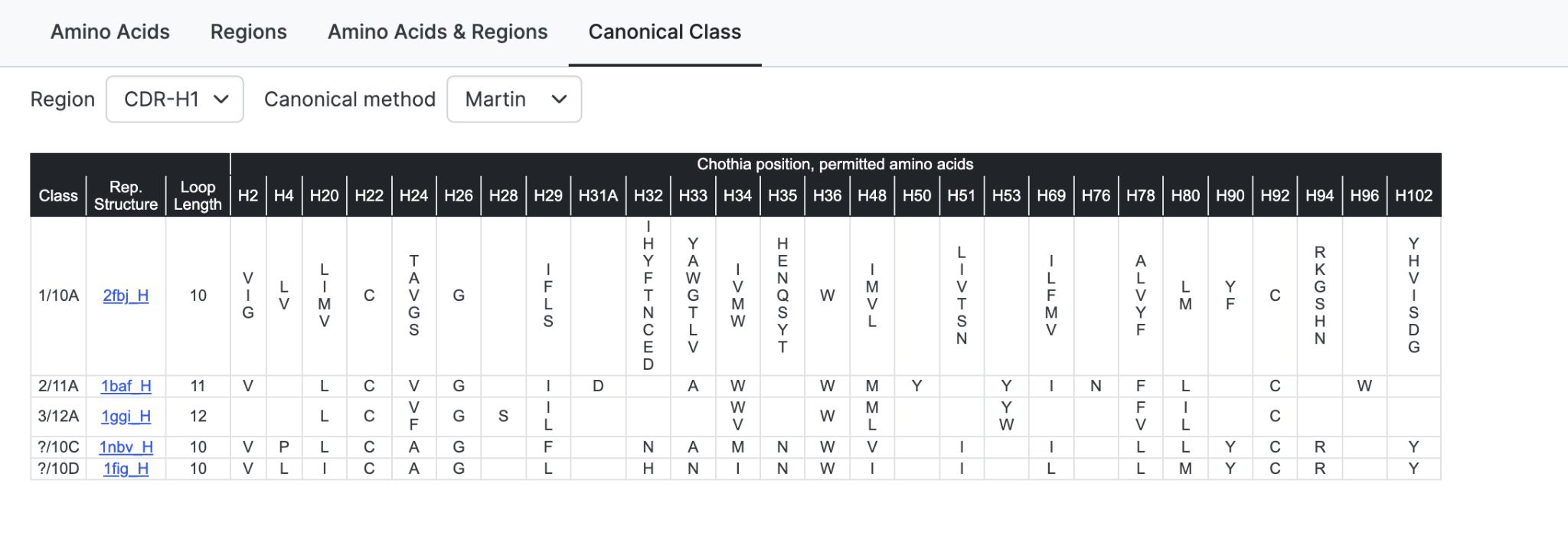-
Overview
-
Sequence Input
-
Database Search
-
Multiple Alignment
-
Key Annotation
-
Structure Input
-
Paired
-
Tools
-
Miscellaneous
-
Statistics
-
Licence File
Canonical Class

CDRs are classified in abYsis using sequence rules which specify loop length and permitted amino acids at required positions. In this way classifications can be made for all numbered sequences, whether or not structural data are available. Use the Region dropdown to select a particular CDR.
Separate CDR classification methods are implemented within abYsis. These differ in the key residues allowed at different positions. Use the Canonical Method dropdown to select a particular method.
The table shows details of the sequence rules for all the canonical classes corresponding to a particular CDR/method combination.
Columns show the permitted amino acids at each required position. These will vary depending on the Canonical Prediction method.
- For an exact match, loop length must agree and the amino acids at each required position must match one of the permitted amino acids.
- For a similar match, loop length must agree but one or more positions might not match one of the permitted amino acids.
Martin
(previously Auto)
The naming scheme is broadly of the form "XX/NNY" where:
XXis the class number given by Chothia (or ? if there is no Chothia class)NNis indeed the loop length (AbM/Martin CDR definition as I recall)Yis the conformation class within that loop length.- Likely to give the most specific results, as based on strict templates derived automatically from available crystal structures.
- Templates generated using automatic protocol involving cluster analysis and analysis of buried hydrophobic and hydrogen bonding residues
- For further reading see; Martin and Thornton, J. Mol. Biol. 263(1996),800-815).
Strict
Strict application of templates derived from papers by Chothia et al.
Relaxed
(previously AbM)
- AbM key residues are based on Chothia templates
(Whitelegg N & Rees AR, Protein Eng. 13(2000),819-24 and Methods Mol. Biol. 248(2004),51-91). - Classes are expanded from the Chothia definitions: some additional allowed residues have been specified together with additional required residues and extra classes.
Classes with a * in the name are not defined by Chothia. - Modifications and references are detailed for each class.
Note
- There are some confusing discrepancies in the canonical class numbers used by Chothia.
- For example CDR-L1 Class 5 is used in earlier papers to refer to a 13-residue lambda light while later papers use class 5 for a 15-residue kappa. Similarly CDR-L1 Class 6 is used in earlier papers to refer to a 14-residues lambda, but later papers use class 6 for a 12-residue kappa. We have used the earlier class numbers.
